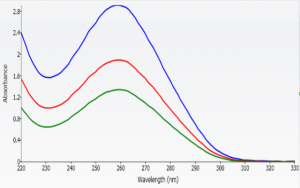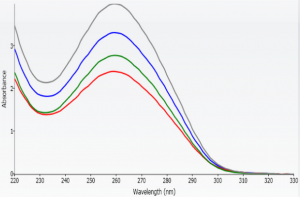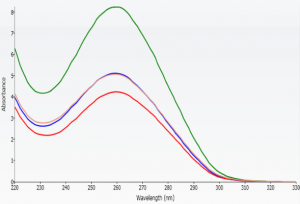Consistent high-quality DNA purification from human and animal tissue: fresh, frozen, fixed (FFPE, ethanol, acetone)
Performance specifications
| Sample | Sample amount | DNA yield (µg) | 260/280 ratio |
|---|---|---|---|
| Fresh tissue | 5-25 mg | 8-45 | 1.7-1.9 |
| FFPE tissue | 5-20 mg | 12-42 | 1.7-1.9 |
| Ethanol-fixed tissue | 5-10 mg | 5-12 | 1.8-1.9 |
Faster, easier, low-cost DNA extraction
- Digestion buffer and proteinase K included for tissue digestion
- Rapid protocols with fewer and simpler steps
- Exceptional quality DNA with high 260/280 and 260/230 ratios for NGS
- Fresh, fixed and FFPE tissue using one kit
- Quick and easy paraffin wax removal with mineral oil dissolution
Buy Swagene Tissue DNA Extraction kit
Kit downloads
Protocols and examples of DNA isolated from various samples
 Sample Preparation for DNA extraction from fresh or frozen tissue
Sample Preparation for DNA extraction from fresh or frozen tissue
Mince or grind fresh or frozen tissue in a mortar and pestle in the presence of liquid nitrogen, or place the mortar and pestle in a box containing dry ice (solid CO2) to mince or grind.
To the right is a graph showing DNA extraction from 3 different samples of human fresh tissue and measured by a nanospectrophotometer.
 Sample preparation for DNA extraction from ethanol or acetone-fixed tissue
Sample preparation for DNA extraction from ethanol or acetone-fixed tissue
- Spin the contents down and discard the supernatant.
- Add adequate PBS (Phosphate buffer saline) and mix by inverting several times.
- Centrifuge at 600 x g (~3000 rpm) for 5 minutes. Discard the supernatant.
- Repeat the PBS wash steps above.
- Mince or grind the tissue pellet.
To the right is a graph showing DNA extraction from 4 different samples of ethanol-fixed human tissue and measured by a nanospectrophotometer.
Sample preparation for DNA extraction from FFPE tissue
- Slice 2-5 10 µm-thick sections of the tissue using a microtome.
- Remove and discard as much paraffin wax as possible leaving the tissue with less paraffin wax.
- Carry out the xylene method for paraffin wax dissolution.
- Perform the ethanol washes for xylene removal.
- Add 1 ml of PBS (phosphate-buffered saline) and mix by inverting several times.
- Centrifuge at 600 x g (~3000 rpm) for 5 minutes. Discard the supernatant. Repeat the PBS wash step.
To the right is a graph showing DNA extraction from 4 different samples of human FFPE tissue and measured by a nanospectrophotometer.
Paraffin wax removal using mineral oil
- Slice 2-5 10 µm-thick sections of the tissue using a microtome.
- Remove and discard as much paraffin wax as possible leaving the tissue with as little paraffin wax as feasible.
- Take the tissue with little paraffin wax into a 1.5 ml tube.
- Add 200 – 500 µl of mineral oil to the tube and incubate at 70°C for 5 – 10 minutes to accelerate wax dissolution.
Note: 200 – 300 µl mineral oil is usually sufficient. However, depending on the amount of wax in the tube, more mineral oil may be required. - Centrifuge at 600 x g (~3000 rpm) for 5 minutes.
- Keep the tube at room temperature (22 – 30°C) for 5 minutes to check for wax resolidification.
Note: If the wax is not fully dissolved, add more mineral oil and repeat the above three steps until the wax is dissolved. - Centrifuge at 600 x g (~3000 rpm) for 5 minutes.
- Carefully remove the upper mineral oil layer containing the dissolved paraffin wax and discard it. Take care to remove the upper mineral oil layer as much as possible.
Downstream applications
High yield and quality of DNA or RNA enable use in several specialized downstream applications
- PCR: conventional PCR, real-time PCR, digital PCR
- Gel electrophoresis and Southern blotting
- Restriction enzyme digestion
- Microarrays
- Sequencing: Sanger, NGS (next generation sequencing)
Kit Contents (50 isolations)
- Digestion Buffer (DD)
- Lysis Buffer (LD-U)
- Wash Buffer, concentrate* (WD)
- Elution Buffer (ED)
- Proteinase K
- Proteinase buffer
- DNA spin columns
- Collection Tubes
- Abridged user manual
* Before use, add 100% ethanol to the concentrated wash buffer to make working WD as specified on the bottle

